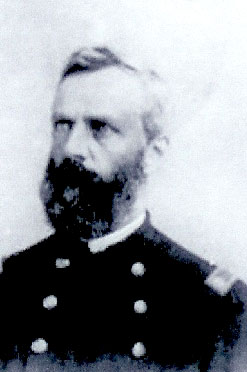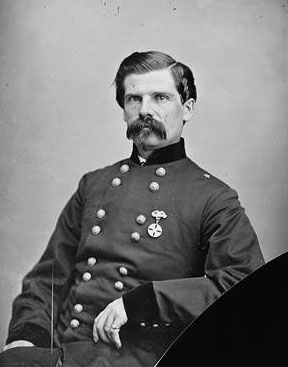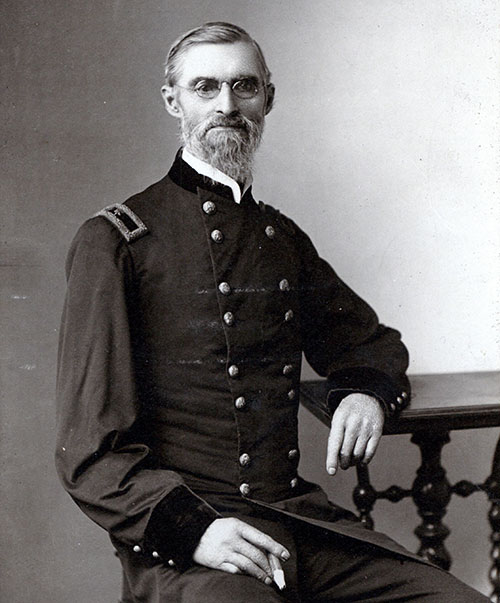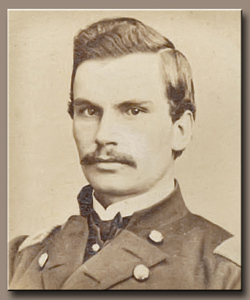Four Civil War generals are buried right here in Springdale Cemetery, but few Peorians know who they are.
In the former Confederate states, it is not unusual for towns and counties to honor citizens of their area who served as generals in the Confederate Army. In the North, however, we rarely celebrate local citizens who served as generals in the Union Army. That is true in Peoria. In fact, most Peorians are unaware that four Civil War generals are buried right here in Springdale Cemetery, and almost no one knows who they are.
By the end of the Civil War, there were 170 generals from Illinois:
- 1 lieutenant general (Ulysses S. Grant);
- 9 major generals;
- 18 brevet major generals;
- 29 brigadier generals; and
- 113 brevet brigadier generals.
During the Civil War, the brevet rank was an honorary designation for courageous or meritorious service, usually awarded at the end of the war. (Today, we give medals.) The four generals buried in Springdale Cemetery were brevet brigadier generals.
 Hamilton Bogart Dox
Hamilton Bogart Dox
At the start of the Civil War, Brigadier General Hamilton Bogart Dox joined the 12th Regiment of the Illinois Cavalry and served in the Army of the Potomac—the principal Union Army in the Eastern Theater. In 1863, the 12th was relieved from duty and returned to Chicago, where Dox recruited three new companies. The new 12th was sent to New Orleans in 1864. After the Civil War, the 12th was stationed in Texas with Dox as its colonel. The regiment was mustered out of service in 1866, and Dox was promoted to brevet brigadier general. General Dox returned to Chicago and worked in the banking industry before passing away in 1890.
So why is he buried in Springdale? General Dox never married. My best guess is that he had family (perhaps a brother) living in Peoria, and they brought him here to be buried in the Mt. Repose section of Springdale.
John Hough
Brigadier General John Hough came to Peoria in 1857 and studied law. At the start of the Civil War, he joined the 17th Illinois Regiment and trained at Camp Lyon in Peoria. Hough was wounded on the way to the Battle of Belmont in Missouri, returned to Peoria and resigned from the 17th in 1862. In 1863, he joined the 77th Illinois Regiment as the adjutant, keeper of its official records. The following year, he was promoted to the staff of Major General A.J. Smith and was the adjutant of the XVI Army Corps. At the end of the Civil War, he was promoted to brevet brigadier general. After the war, Hough lived in the South and was named Vice Counsel to Panama in 1867. In 1873, General Hough returned to Peoria, where he practiced law until his death in 1891. He is the only general buried on Soldier’s Hill, where hundreds of other military veterans lie in their final resting place.
 David Magee
David Magee
Born in Pennsylvania, Brigadier General David Magee served in the Mexican War and came to Henry, Illinois, in 1853, then Peoria in 1856. In 1862, he joined the 86th Illinois Regiment, fighting in the battles of Perryville and Chickamauga. Illness forced him to resign in 1864. With the death of the colonel of the 47th Illinois Regiment in 1865, David Magee was commissioned the new colonel of the 47th. At the end of the Civil War, he was promoted to brevet brigadier general. During the Reconstruction period, General Magee served as commander of a federal district in Alabama. From 1867 to 1877, he was the Peoria postmaster, and in 1879 he moved to Chicago to study medicine. From 1880 to 1890, he practiced medicine in Wyoming, Illinois, then returned to Peoria, where he practiced medicine on the south side. In addition, General Magee was prominent in the thoroughbred horse racing scene here. He died in 1910 and is buried in the Mt. Auburn section of Springdale.
 David Grier
David Grier
Our last Springdale general is Brevet Brigadier General David Grier, who moved to Peoria in 1851. In 1861, he raised a company called the Elmwood Guards and became its captain. Because the Illinois regiment quota was full, the Elmwood Guards joined a Missouri regiment. They fought in the battles of Belmont, Ft. Henry, Ft. Donelson and Shiloh. David Grier’s leadership was recognized, and he was commissioned colonel of the 77th Illinois Regiment when it was formed in 1862.
The 77th under Colonel Grier served under General William Tecumseh Sherman in the battles of Chickasaw Bayou and Arkansas Post. Then it served under General U.S. Grant in the Vicksburg campaign, fighting in the battles of Port Gibson, Champions Hill and Big Black River and joining in the Vicksburg siege. In 1863, Colonel Grier was given command of a brigade, which served in the Vicksburg area until the end of the Civil War. Like the other Peorians, he was promoted to brevet brigadier general at the end of the war.
I believe David Grier should have been given a full brigadier general’s rank during the war. He may not have been given the promotion because his brigade served in the war’s backwaters after the Vicksburg campaign.
After the war, General Grier returned to Peoria, where his family was prominent in the grain trade. He built the first grain elevator in Peoria in 1866 and became president of the Peoria Board of Trade in 1875. General Grier moved to St. Louis in 1881 and died there in 1891, but was returned to Peoria for burial in the Prospect Hill North section of Springdale.
Model Citizens
A book about Illinois’ Civil War officers says this about General Hamilton Bogart Dox: “He lived as a model citizen, respected by all who knew him and loved by those who knew him best.” This can be said for all the generals and the other Civil War veterans buried in Springdale Cemetery. They volunteered, they served and they came back home to become respected citizens. I hope learning about our generals buried there helps you appreciate the sacrifice of all those who served. iBi


